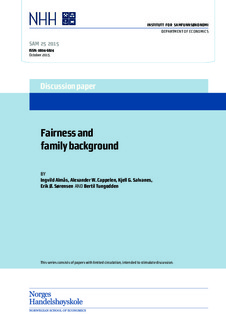Fairness and family background
Working paper

Åpne
Permanent lenke
http://hdl.handle.net/11250/2357464Utgivelsesdato
2015-10Metadata
Vis full innførselSamlinger
- Discussion papers (SAM) [657]
Sammendrag
Fairness preferences fundamentally affect individual behavior and play an
important role in shaping social and political institutions. However, people differ
both with respect to what they view as fair and with respect to how much
weight they attach to fairness considerations. In this paper, we study the role of
family background in explaining these heterogeneities in fairness preferences. In
particular, we examine how socioeconomic background relates to fairness views
and to how people make trade-offs between fairness and self-interest. To study
this we conducted an economic experiment with a representative sample of 14-15
year-olds and matched the experimental data to administrative data on parental
income and education. The participants made two distributive choices in the
experiment. The first choice was to distribute money between themselves and
another participant in a situation where there was no difference in merit. The
second choice was to distribute money between two other participants with unequal
merits. Our main finding is that there is a systematic difference in fairness
view between children from low socioceconomic status (SES) families and the
rest of the participants; more than 50 percent of the participants from low SES
families are egalitarians, whereas only about 20 percent in the rest of the sample
hold this fairness view. In contrast, we find no significant difference in the weight
attached to fairness between children from different socioeconomic groups.